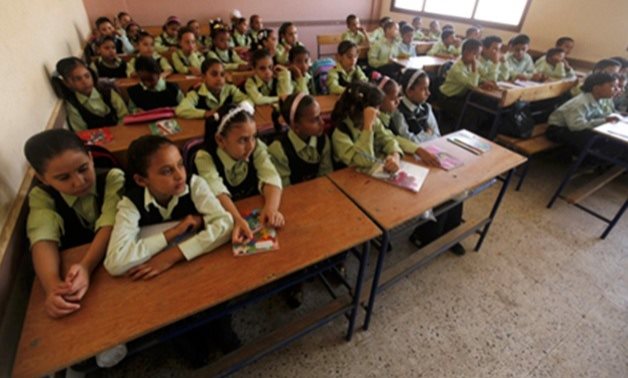
Students attend class on the first day of their new school year at a government school in Giza, south of Cairo, September 22, 2013 (Photo: Reuters)
CAIRO – 21 April 2022: Tens of schools have been built in Upper Egyptian governorates within Decent Life initiative, as announced by officials Wednesday and Thursday.
Governor of Asyut Essam Saad stated that Decent Life initiative is implementing 88 schools, consisting of a total of 1,228 classrooms, planned for low-income villages in the governorate with a budget of LE430.2 million.
The governor noted that 87 of those, comprising a total of 1,219 classrooms, have been delivered since July 2020 with a cost of LE426,6 million. Saad clarified that once the remaining school, encompassing nine classrooms, is finished, all of those establishments will be officially inaugurated to enter service.
Equally, in the neighboring governorate of Sohag, Governor Tarek al-Feqy stated that Decent Life initiative built 87 schools out of 125. The completed schools have a total of 1,115 classrooms and are worth LE436.2 million.
By December, LE103 billion were spent through the initiative on 600 projects located across 377 villages at 11 governorates. Those are in the sectors of healthcare, education, infrastructure, sports, culture, and job creation.
Head of the Central Administration of Decent Life Initiative Alaa Gad al-Karim stated in September that the development of 1,413 rural villages - out of targeted 4,500 - will be accomplished by June 30, 2022, and that the upgrade of the entire Egyptian countryside will be completed by June 30, 2024.
Assistant to Minister of Planning for Sustainable Development Gamil Helmy unveiled in May that 89 percent of the budget disbursed within the first phase of Decent Life initiative was directed to Upper Egypt so as 334 out of 375 villages received LE8.5 billion. The official further added that 94 percent of beneficiaries at that phase live in Upper Egypt.
The budget allocated to the entire initiative is LE700 billion, and the number of beneficiaries is 58 million.
The goals of the initiative are as follows:
Rehabilitating houses, building ceilings for houses that lack them, and building residential communities in villages in need.
Connecting the houses to water supply, wastewater, natural gas, and electricity networks.
Introducing infrastructure necessary for micro enterprises.
Providing medical services, building hospitals and healthcare units, and equipping them with the necessary devices and medical staff.
Operating medical caravans, and offering prosthetics.
Improving the quality of schools, and nurseries, and establishing literacy classrooms.
Expanding economic empowerment, vocational training, and employment through micro, small, and medium enterprises.
Establishing industrial, and craft complexes.
Bolstering food supply chains, and providing subsidized food.
Comments
Leave a Comment